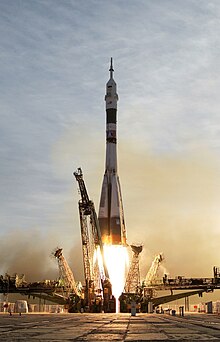Chemical energy

As chemical energy which is energy form referred to in the form of a chemical compound in an energy is stored and chemical reactions can be released. The term goes back to Wilhelm Ostwald , who wrote it in 1893 in his textbook “Chemical Energy” (in the pair of terms “Chemical and Internal Energy”) alongside other forms of energy (“Mechanical Energy”, “Heat”, “Electrical and Magnetic Energy” and “Radiant Energy ”).
The term chemical energy macroscopically describes the energy that is associated with electrical forces in atoms and molecules and that has an effect in chemical reactions. It can be divided into kinetic energy of electrons and potential energy of electromagnetic interaction between electrons and atomic nuclei . It is an internal energy like thermal energy and nuclear energy .
Use of the term chemical energy
In chemistry , the term “chemical energy” is not used. It is only clearly defined by specifying the environmental conditions - there is then a different established name for each.
Chemical energy often refers to the energy that is released when a substance burns (at constant pressure ), i.e. the enthalpy of combustion . The set of Hess allows calculation of the energy in transformations from the precisely defined of formation of the compounds involved. Similar terms are net calorific value and gross calorific value , each targeting the maximum amount of heat that can be used during combustion.
The chemical energy must not be confused with the chemical binding energy . The chemical binding energy describes the strength of a particular chemical bond , thus indicates how much energy the molecule to dissolve the bond supplied must be.
In other natural sciences, engineering, etc., the term chemical energy is used widely in its partially fuzzy form. Although some physics educators criticize the use of the term ("The term is useful when it comes to a rough orientation, but proves to be stubborn if one tries to grasp it strictly. In physical jargon it is useful, in physical calculus it is superfluous, for physical understanding obstructive. ”) it is used in practically all didactic publications and school books.
Use of chemical energy in technical systems
From a technical point of view , fuels store chemical energy that is converted into mechanical energy when they are burned , for example when driving vehicles . Fuel cells allow the conversion of chemical reaction energy from combustion directly into electrical energy . When using batteries , chemical energy is converted directly into electrical energy via electrochemical redox reactions . When using energy, an accumulator behaves similarly to a battery, but it can also convert electrical energy into chemical energy and thus store it.
Use of chemical energy in biological systems
From a biological perspective in organic is food chemical energy stored in ATP molecules as energy converted is. Green plants get their chemical energy not from organic food, but from the energy content of solar radiation, some bacteria from the oxidation energy of reduced compounds (e.g. Fe 2+ or CH 4 ). The ATP molecules within the biological cells allow chemical, osmotic and mechanical work to be carried out.
literature
- Wilhelm Ostwald: Textbook of general chemistry. Volume II, Part I: Chemical Energy. 2nd, revised edition. W. Engelmann, Leipzig 1893. (Reprint: Wilhelm Ostwald: Die Energie . BoD - Books on Demand, 2012, ISBN 978-3-8457-4220-5 , p. 133– ( google.com [accessed June 12, 2013]). )
- Dieter Meschede: Gerthsen Physics . Springer DE, 2010, ISBN 978-3-642-12894-3 , pp. 304– ( google.com [accessed June 13, 2013]). - Chapter 6.6.8 "Chemical energy"
Individual evidence
- ↑ "Chemical energy is based on the fact that chemical bonds can change into other chemical bonds with the release of heat and work ..." Karl-Heinz Lautenschläger: Taschenbuch der Chemie . Harri Deutsch Verlag, 2007, ISBN 978-3-8171-1761-1 , pp. 264– ( google.com [accessed June 12, 2013]).
- ^ Wilhelm Ostwald: Chemical energy. ( Memento from June 19, 2013 in the web archive archive.today ) 1911.
- ↑ Marcelo Alonso, Edward J. Finn: Quantum Physics and Statistical Physics . Oldenbourg Verlag, 2011, ISBN 978-3-486-71340-4 , pp. 505- ( google.com ).
- ^ Richard Phillips Feynman, Robert Benjamin Leighton, Matthew Linzee Sands: Feynman lectures on physics 1: mechanics, radiation, heat. Definitive edition . Oldenbourg Verlag, 2007, ISBN 978-3-486-58108-9 , pp. 54- ( google.com ).
- ↑ Friedhelm Kuypers: Physics for Engineers and Natural Scientists: Volume 1 - Mechanics and Thermodynamics . John Wiley & Sons, 2012, ISBN 978-3-527-66957-8 , pp. 248– ( google.com [accessed June 13, 2013]).
- ↑ Chemical energy as the “legacy of physics” (PDF; 40 kB).
- ↑ Jörg Willer: Didactics of physics lessons . Harri Deutsch Verlag, 2003, ISBN 3-8171-1693-4 , pp. 212– ( google.com [accessed June 13, 2013]).
- ↑ Victor F. Weisskopf: Physics is that simple. 6. Chemical energy. In: Physics and Didactics. 16, 3, 1988, pp. 177-181.
- ↑ Martin Bader: Comparative study of a new course "Introduction to mechanical energy and heat theory". Dissertation . (PDF; 1.4 MB)
- ↑ D. Plappert: Physical concepts applied to chemical reactions. ( Memento from November 20, 2013 in the Internet Archive ) (PDF; 377 kB). PdN-PhiS. 54th volume, 3, 2005.
- ↑ "Chemical energy is the energy that is based on the bonding forces of the atoms in the molecule. It is released and converted into internal thermal energy when chemical processes split the molecules into their atomic building blocks and these form new molecules. ”(Wolfgang Geller: Thermodynamik für Maschinenbauer: Basics for Practice . Springer DE, 2006 , ISBN 3-540-32320-1 , pp. 85– ( google.com [accessed June 12, 2013]). ).


